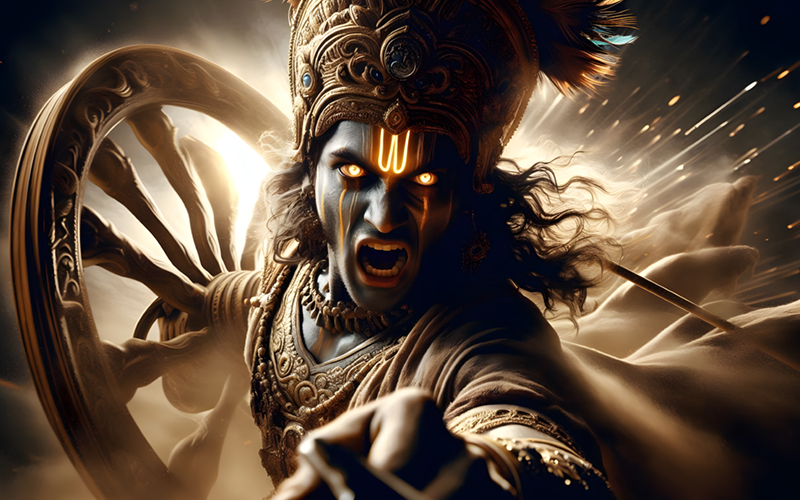Physical Address
Empirical System, 105 First Floor Pitru Krupa, Opp. R.K. Desai College, Koparli Road, Vapi (Gujarat) 396 191
Physical Address
Empirical System, 105 First Floor Pitru Krupa, Opp. R.K. Desai College, Koparli Road, Vapi (Gujarat) 396 191

Shri Krishna’s Divine Intervention in the Kurukshetra War
In the epic tale of the Mahabharata, the Kurukshetra War was no ordinary battle. It was a cosmic struggle between the forces of dharma (righteousness) and a dharma (unrighteousness), between the virtuous Pandavas and the power-hungry Kauravas. Lord Krishna, who served as the charioteer and divine guide for Arjuna, had vowed not to take up arms during this war. However, there came a crucial moment when Krishna nearly broke his vow to uphold righteousness.
The Oath of Lord Krishna
Before the onset of the war, Lord Krishna made a solemn promise that he would not wield any weapon or directly engage in the combat. Instead, he chose to be Arjuna’s charioteer, offering wisdom and strategic counsel to ensure the victory of dharma. This vow was a testament to Krishna’s role as a divine strategist and protector of righteousness.
Bhishma’s Vow
On the opposite side of the battlefield was Bhishma, the revered grandsire of both the Pandavas and Kauravas. Bhishma was one of the greatest warriors renowned for his unmatched prowess and valor, Bhishma had pledged to fight for the Kauravas with all his strength, fulfilling his duty as their commander. He was bound by his allegiance to the throne of Hastinapura and committed to leading the Kaurava army, despite his personal affection for the Pandavas.
The Intensity of the Battle
On the tenth day of the war, Bhishma fought with extraordinary ferocity, creating an onslaught that the Pandavas struggled to withstand. His arrows rained down like a storm, causing significant casualties and pushing the Pandava forces to the brink of despair. Even Arjuna, the greatest warrior of the Pandavas, found himself unable to counter Bhishma’s relentless attacks effectively.
Krishna’s Decision to Lift a Weapon
Observing the dire situation of the Pandavas and Arjuna’s struggle against Bhishma, Lord Krishna was filled with divine wrath. He realized that if Bhishma’s rampage continued unchecked, the Pandavas would face inevitable defeat.
In a moment of profound determination, Krishna decided to intervene directly. He leaped off the chariot, lifted a chariot wheel from the battlefield, and charged toward Bhishma, ready to strike him down. This dramatic action was symbolic of Krishna’s unwavering commitment to protecting dharma, even if it meant breaking his own vow.
Bhishma’s Reaction
As Krishna advanced toward him with the chariot wheel, Bhishma experienced a profound sense of joy and reverence rather than fear. He welcomed the opportunity to be slain by Krishna, acknowledging the divine nature of Krishna’s intervention.
Bhishma saw this as a moment of honor and was prepared to lay down his life at the hands of the Supreme Being, understanding that his death at Krishna’s hands would be a fitting end to his duty.
Arjuna’s Intervention
Just as Krishna was about to strike, Arjuna rushed forward and pleaded with Krishna to stop. He reminded Krishna of his vow and promised to find a way to defeat Bhishma without Krishna needing to break his promise. Arjuna’s plea was earnest and filled with determination to uphold the battle without Krishna having to intervene directly with force.
Moved by Arjuna’s words and determination, Krishna paused. He placed the chariot wheel back on the ground and returned to his role as the charioteer, allowing Arjuna to continue fighting.
After Krishna returned to the chariot, Arjuna was filled with renewed determination and vigor. He understood the gravity of the situation and resolved to defeat Bhishma using his own skills and ingenuity. Krishna’s restraint inspired Arjuna to rise to the challenge and fulfill his duty as a warrior of dharma.
Significance of the Event
The incident of Krishna nearly breaking his vow carries profound significance within the Mahabharata:
Application in Today’s Life
In contemporary life, the story of Lord Krishna lifting a weapon serves as a timeless reminder that standing up for what is right may sometimes require challenging our own limitations and commitments. It teaches us that true leadership involves making difficult decisions to protect justice and uphold the greater good, even when it means bending rules for the sake of righteousness.
Just as Krishna guided the Pandavas toward victory, we too must strive to uphold dharma in our lives, ensuring that our actions contribute to the triumph of good over evil.